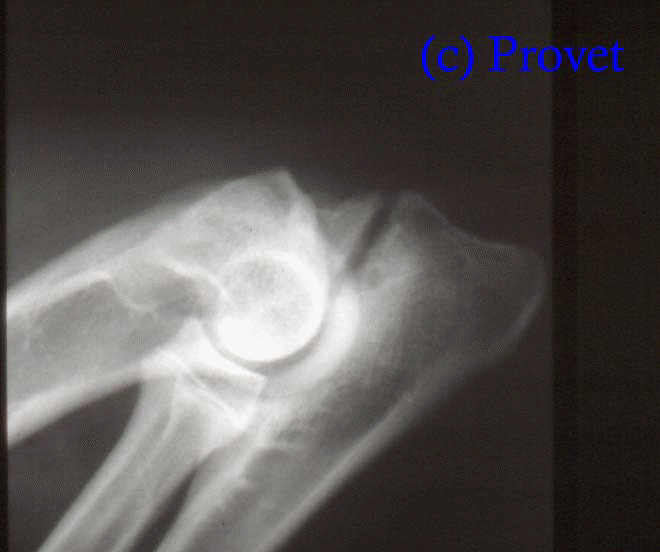
|
UNUNITED ANCONEAL PROCESS
(ELBOW DYSPLASIA)
This information is provided by
Provet for educational purposes only.
You should seek the advice of
your veterinarian if your pet is ill as only he or she can correctly advise
on the diagnosis and recommend the treatment that is most appropriate for
your pet. Note for Pet Owners: Topics on this Page:
|
Description
The anconeal process is a bony protrusion which forms part of the ulna bone at
the back of the elbow joint. In very young animals this part of the ulna is
still cartilage and bone is laid down from within it's own ossification centre.
Sometimes, the anconeal process does not fuse on to the main body of the ulna,
in which case it forms a separate bone and is called an ununited anconeal
process.
On this XRay of the flexed elbow of a young dog with the condition, you can clearly see a dark line like a fracture line (labelled DL) which separates the ununited anconeal process (labelled AP) from the ulna (labelled U)

Cause
Because inheritance may be important owners should have their animals screened by XRay and they should not breed from affected individuals.
Other possible causative factors include :
- Trauma to the anconeal process which might cause a fracture along the line separating the developing process from the ulna bone.
- Other orthopaedic conditions such as short radius disease may play a role, as pressure put on the lower part of the humerus by the radius may push the humerus backwards causing sheering forces along the line along which the anconeal process should fuse to the ulna.
Breed Occurrence
Ununited anconeal process usually affects large and giant breeds of dog
including the Afghan, Bullmastiff, French Bulldog, Great Dane, Irish Wolfhound,
Labrador Retriever, Pointer, Pyrenean Mountain Dog, St Bernard and Weimeraner.
It has also been reported in achondroplastic breeds - the Bassett Hound and the
Dachshund. However, by far the most frequent number of reported cases come from
German Shepherd Dogs.
Signs
Signs usually appear as an intermittent lameness at 5-9 months of age. The condition most often only affects one elbow - but it can affect both.
Some dogs may not show any apparent sign of lameness.
Complications
Diagnosis
Flexing.and extending the elbow joint usually causes a grating feeling (crepitus),
and the animal may feel moderate pain. Sometimes the elbow joint is swollen with
fluid.
The diagnosis is confirmed by taking XRays of the elbow joint. The flexed lateral view is best as this throws the anconeal process away from the other bony structures of the elbow - making it easier to see.
Treatment
Strict rest with external support can result in fusion in very young animals.
However, because of the potential for secondary osteoarthritic change most
orthopaedic specialists prefer to operate early to either :
- Fix the anconeal process in place (using a lag screw technique) to try to achieve healing across the non-union, or
- Remove the bony fragment from the joint.
Fixing the process back to the ulna can only be carried out if there is little or no evidence of osteoarthrosis in the joint. Removal of the fragment is a very rewarding procedure and is the one most often performed in first opinion practice.
Prognosis
The long term prognosis for these cases is generally good, although some dogs
will have a reduced range of movement within the joint, and some will develop
chronic degenerative joint disease.
Long term problems
Updated October 2013
d>